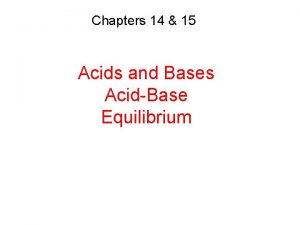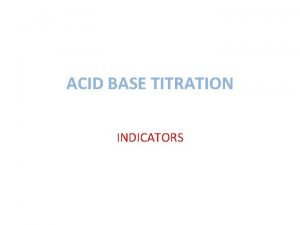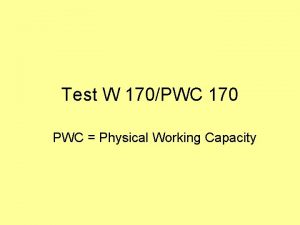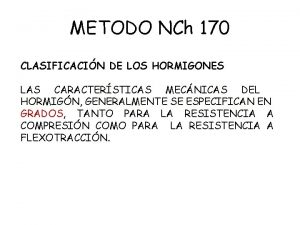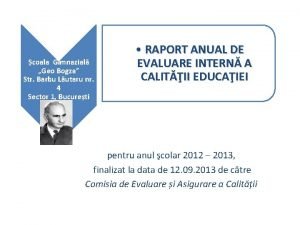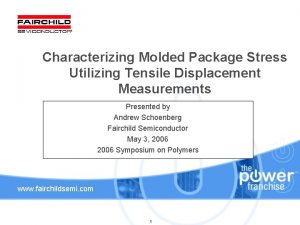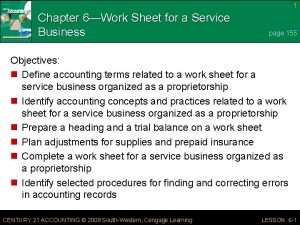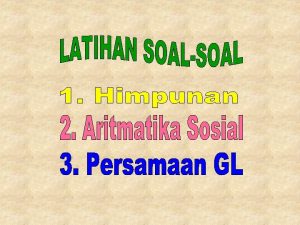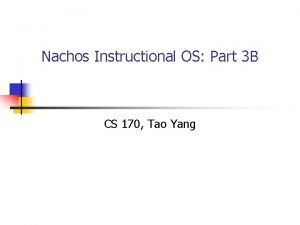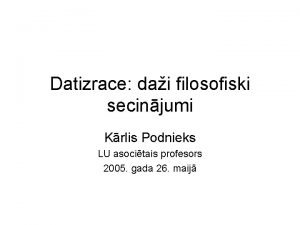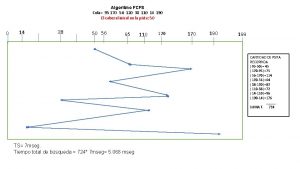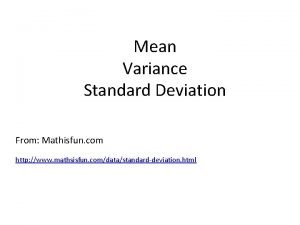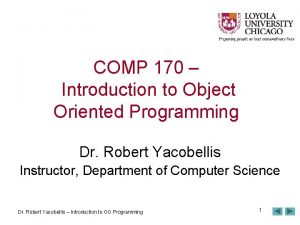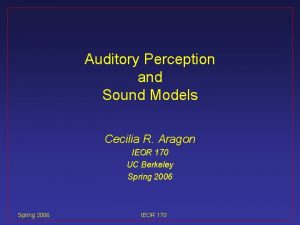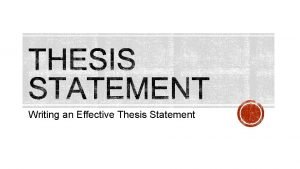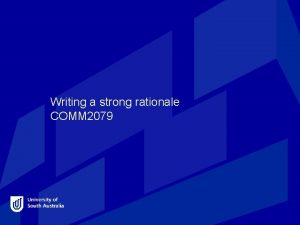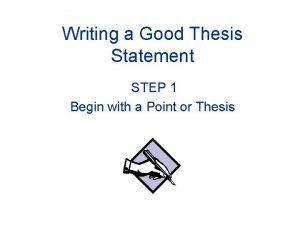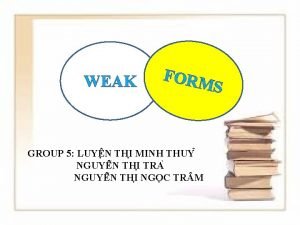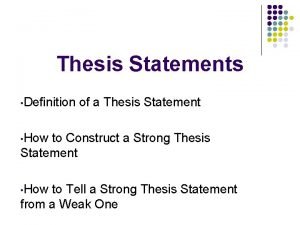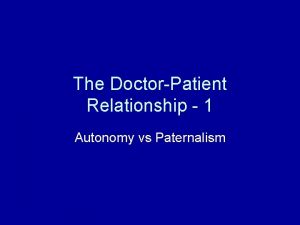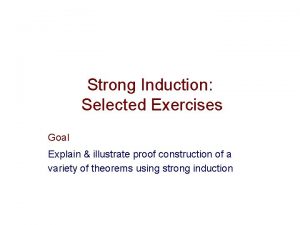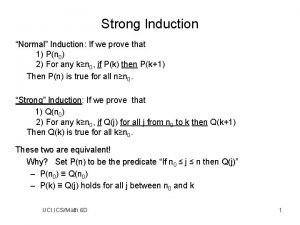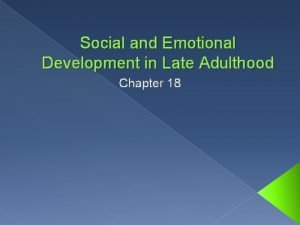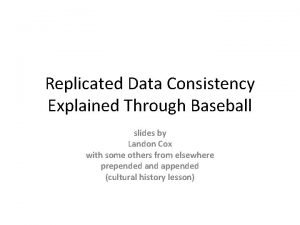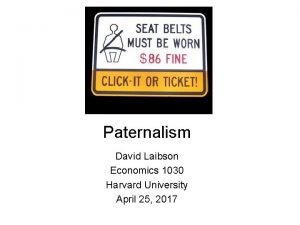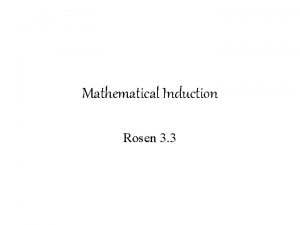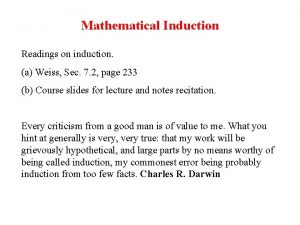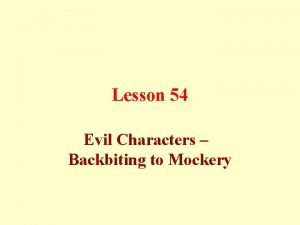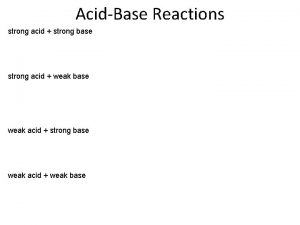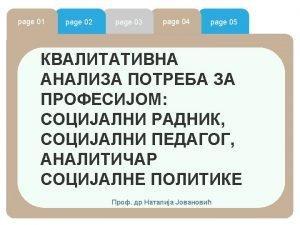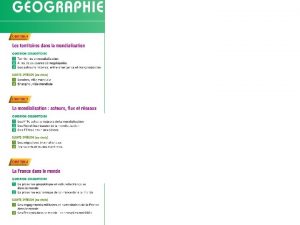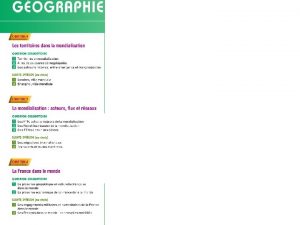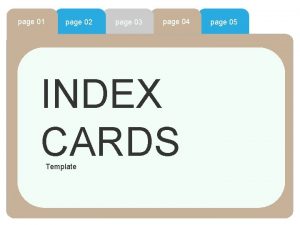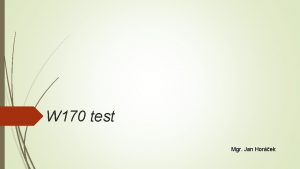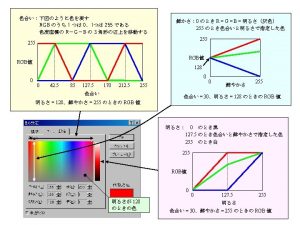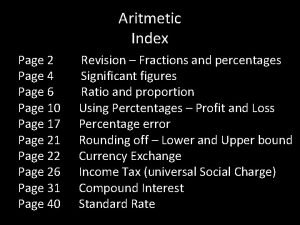Practice Practice Page 170 6 10 How strong








































































- Slides: 72


Practice • Practice – Page 170 #6. 10 – How strong is the relationship?

Results X 2 = 5. 38 X 2 crit = 3. 83 ADD English

Phi • Use with 2 x 2 tables


2 as a test for goodness of fit • But what if: • You have a theory or hypothesis that the frequencies should occur in a particular manner?

Example • • M&Ms claim that of their candies: 30% are brown 20% are red 20% are yellow 10% are blue 10% are orange 10% are green

Example • Based on genetic theory you hypothesize that in the population: • 45% have brown eyes • 35% have blue eyes • 20% have another eye color

To solve you use the same basic steps as before (slightly • • different order) 1) State the hypothesis 2) Find 2 critical 3) Create data table 4) Calculate the expected frequencies 5) Calculate 2 6) Decision 7) Put answer into words

Example • M&Ms claim that of their candies: • • • 30% are brown 20% are red 20% are yellow 10% are blue 10% are orange 10% are green

Example • Four 1 -pound bags of plain M&Ms are purchased • Each M&Ms is counted and categorized according to its color • Question: Is M&Ms “theory” about the colors of M&Ms correct?


Step 1: State the Hypothesis • H 0: The data do fit the model – i. e. , the observed data does agree with M&M’s theory • H 1: The data do not fit the model – i. e. , the observed data does not agree with M&M’s theory – NOTE: These are backwards from what you have done before

Step 2: Find 2 critical • df = number of categories - 1

Step 2: Find 2 critical • df = number of categories - 1 • df = 6 - 1 = 5 • =. 05 • 2 critical = 11. 07

Step 3: Create the data table

Step 3: Create the data table Add the expected proportion of each category

Step 4: Calculate the Expected Frequencies

Step 4: Calculate the Expected Frequencies Expected Frequency = (proportion)(N)

Step 4: Calculate the Expected Frequencies Expected Frequency = (. 30)(2081) = 624. 30

Step 4: Calculate the Expected Frequencies Expected Frequency = (. 20)(2081) = 416. 20

Step 4: Calculate the Expected Frequencies Expected Frequency = (. 20)(2081) = 416. 20

Step 4: Calculate the Expected Frequencies Expected Frequency = (. 10)(2081) = 208. 10

Step 5: Calculate 2 O = observed frequency E = expected frequency

2

2

2

2

2

2 15. 52

Step 6: Decision • Thus, if 2 > than 2 critical – Reject H 0, and accept H 1 • If 2 < or = to 2 critical – Fail to reject H 0

Step 6: Decision • Thus, if 2 > than 2 critical – Reject H 0, and accept H 1 • If 2 < or = to 2 critical – Fail to reject H 0 2 = 15. 52 2 crit = 11. 07

Step 7: Put it answer into words • H 1: The data do not fit the model • M&M’s color “theory” did not significantly (. 05) fit the data

Practice • Among women in the general population under the age of 40: • • • 60% are married 23% are single 4% are separated 12% are divorced 1% are widowed

Practice • You sample 200 female executives under the age of 40 • Question: Is marital status distributed the same way in the population of female executives as in the general population ( =. 05)?


Step 1: State the Hypothesis • H 0: The data do fit the model – i. e. , marital status is distributed the same way in the population of female executives as in the general population • H 1: The data do not fit the model – i. e. , marital status is not distributed the same way in the population of female executives as in the general population

Step 2: Find 2 critical • df = number of categories - 1

Step 2: Find 2 critical • df = number of categories - 1 • df = 5 - 1 = 4 • =. 05 • 2 critical = 9. 49

Step 3: Create the data table

Step 4: Calculate the Expected Frequencies

Step 5: Calculate 2 O = observed frequency E = expected frequency

2 19. 42

Step 6: Decision • Thus, if 2 > than 2 critical – Reject H 0, and accept H 1 • If 2 < or = to 2 critical – Fail to reject H 0

Step 6: Decision • Thus, if 2 > than 2 critical – Reject H 0, and accept H 1 • If 2 < or = to 2 critical – Fail to reject H 0 2 = 19. 42 2 crit = 9. 49

Step 7: Put it answer into words • H 1: The data do not fit the model • Marital status is not distributed the same way in the population of female executives as in the general population ( =. 05)


Practice • In the past you have had a 20% success rate at getting someone to accept a date from you. • What is the probability that at least 2 of the next 10 people you ask out will accept?

Practice • p zero will accept =. 11 • p one will accept =. 27 • p zero OR one will accept =. 38 • p two or more will accept = 1 -. 38 =. 62


Practice • IQ – Mean = 100 – SD = 15 • What is the probability that the stranger you just bumped into on the street has an IQ between 95 and 110?

Step 1: Sketch out question 95 110 ? -3 -2 -1 1 2 3

Step 2: Calculate Z scores for both values • Z = (X - ) / • Z = (95 - 100) / 15 = -. 33 • Z = (110 - 100) / 15 =. 67

Step 3: Look up Z scores -. 33 -3 -2 . 67 . 1293 . 2486 -1 1 2 3

Step 4: Add together the two values -. 33 . 67. 3779 -3 -2 -1 1 2 3


Practice • A professor would like to determine if there has been a change in grading practices over the years. In the past, the overall grade distribution was 14% As, 26% Bs, 31% Cs, 19% Ds, and 10% Fs. • A sample of 200 students this years had the following grades

Practice • • • A = 32 B = 61 C = 64 D = 31 F = 12 • Do the data indicate a significant change in the grade distribution? Test at the. 05 level.

Step 1: State the Hypothesis • H 0: The data do fit the model – i. e. , the grades are distributed the same • H 1: The data do not fit the model – i. e. , the grades are not distributed the same

Practice • • • A = 32 B = 61 C = 64 D = 31 F = 12 28 52 62 38 20 • Chi square = 6. 68 • Critical Chi square (4) = 9. 49

Step 6: Decision • Thus, if 2 > than 2 critical – Reject H 0, and accept H 1 • If 2 < or = to 2 critical – Fail to reject H 0 2 = 6. 68 2 crit = 9. 49

Step 7 • H 0: The data do fit the model – i. e. , the grades are distributed the same • There is no evidence that the grades have changed

Practice • An early hypothesis of schizophrenia was that it has a simple genetic cause. In accordance with theory 25% of the offspring of a selected group of parents would be expected to be diagnosed as schizophrenic. Suppose that of 140 offspring, 19. 3% were schizophrenic. Test this theory.

• Goodness of fit chi-square • Make sure you compute the Chi square with the frequencies. • Chi square observed = 2. 439 • Critical = 3. 84 • These data are consistent with theory!


Practice • In the 1930’s 650 boys participated in the Cambridge-Somerville Youth Study. Half of the participants were randomly assigned to a delinquency-prevention pogrom and the other half to a control group. At the end of the study, police records were examined for evidence of delinquency. In the prevention program 114 boys had a police record and in the control group 101 boys had a police record. Analyze the data and write a conclusion.

• Chi Square observed = 1. 17 • Chi Square critical = 3. 84 • Phi =. 04 – Note the results go in the opposite direction that was expected!

Practice • In 1693, Samuel Pepys asked Isaac Newton whether it is more likely to get at least one ace in 6 rolls of a die or at least two aces in 12 rolls of a die. This problems is known a Pepys' problem.

Binomial Distribution p =. 67 p Aces

Binomial Distribution p =. 62 p Aces

Practice • In 1693, Samuel Pepys asked Isaac Newton whether it is more likely to get at least one ace in 6 rolls of a die or at least two aces in 12 rolls of a die. This problems is known a Pepys' problem. • It is more likely to get at least one ace in 6 rolls of a die!

 Be strong be strong be strong in the lord
Be strong be strong be strong in the lord Strong acid-strong base titration indicator
Strong acid-strong base titration indicator Weak acid strong base titration curve
Weak acid strong base titration curve How to remember strong acids and strong bases
How to remember strong acids and strong bases Acid base titration curves
Acid base titration curves Strong acods
Strong acods Buffer net ionic equation
Buffer net ionic equation Apa title format
Apa title format Pwc 170 test
Pwc 170 test Resistencia media requerida
Resistencia media requerida 350-170-120
350-170-120 Scoala gimnaziala geo bogza
Scoala gimnaziala geo bogza 170 mpa
170 mpa Trc-170 technical manual
Trc-170 technical manual Trc-170
Trc-170 350 rounded to the nearest hundred
350 rounded to the nearest hundred 6-4 work together p. 170
6-4 work together p. 170 Tang and song dynasty achievements
Tang and song dynasty achievements Numberblocks 170
Numberblocks 170 If an aquarium holds 80 l of water and contains 170 guppies
If an aquarium holds 80 l of water and contains 170 guppies Jika s bilangan asli dan d
Jika s bilangan asli dan d 21cfr211.170
21cfr211.170 Cs 170
Cs 170 Reference dimension
Reference dimension 170 f a c
170 f a c Ee 170 purdue
Ee 170 purdue 1629-1695
1629-1695 170 + 56
170 + 56 Wechsler adult intelligence test
Wechsler adult intelligence test Mean absolute deviation math is fun
Mean absolute deviation math is fun A 170 g sample of an unidentified compound contains
A 170 g sample of an unidentified compound contains Nch 170
Nch 170 25 cfr 170
25 cfr 170 Comp 170
Comp 170 Cecilia r aragon
Cecilia r aragon Lesson 7-1 multiplication properties of exponents
Lesson 7-1 multiplication properties of exponents Segments and distance worksheet answers a#2-3
Segments and distance worksheet answers a#2-3 Myeplg
Myeplg H2so4 strong or weak
H2so4 strong or weak Example of thesis statement
Example of thesis statement What is a rationale
What is a rationale Thesis statement with reason
Thesis statement with reason All strong acids
All strong acids Weak forms examples
Weak forms examples Strong ai vs weak ai
Strong ai vs weak ai 7 strong acid
7 strong acid 9-which acid is not considered a strong acid?
9-which acid is not considered a strong acid? Todo lo que el hombre sembrare
Todo lo que el hombre sembrare Two prong thesis statement example
Two prong thesis statement example Quotation hooks examples
Quotation hooks examples Deontological
Deontological Wizard lizard superworm
Wizard lizard superworm Strong induction exercises
Strong induction exercises Strong induction
Strong induction What is weak syllable
What is weak syllable Adjectives for normal
Adjectives for normal Strong acids and bases
Strong acids and bases Six strong acids
Six strong acids Elders housing preferences reflect a strong desire for
Elders housing preferences reflect a strong desire for Strong and weak semaphore
Strong and weak semaphore Theory of indicators
Theory of indicators Replicated data consistency explained through baseball
Replicated data consistency explained through baseball Cardinality ratio constraint adalah :
Cardinality ratio constraint adalah : Strong paternalism
Strong paternalism Strong paragraph
Strong paragraph Fantail of a ship
Fantail of a ship Arrhenius acid examples
Arrhenius acid examples Strong induction
Strong induction Strong induction
Strong induction A strong affection for another person due to kinship
A strong affection for another person due to kinship Strong believer is better than weak
Strong believer is better than weak Precipitation of proteins by strong mineral acids
Precipitation of proteins by strong mineral acids Strong vs weak electrolytes
Strong vs weak electrolytes



